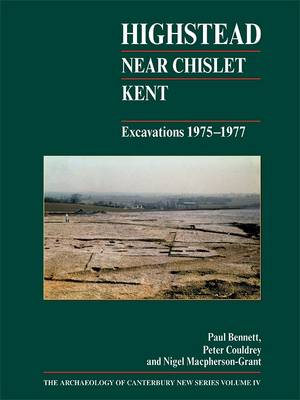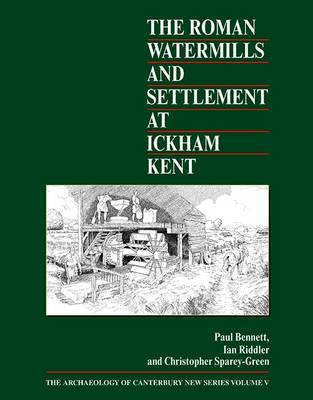Archaeology of Canterbury
2 primary works
Book 4
Highstead, near Chislet, Kent
by Paul Bennett, Peter Couldrey, and Nigel Macpherson-Grant
Published 1 December 2007
In the Foreword, Barry Cunliffe writes: "The publication of the excavation of the multi-period settlement site at Highstead near Chislet is a matter for celebration. Highstead, with its long sequence of occupation spanning the first millennium B.C. and early first millennium A.D., was excavated under difficult conditions between 1975 and 1977 in those pioneering days when rescue archaeology was in its infancy. It is a story well told by Paul Bennett in his preface and is a stark reminder of how hand-to-mouth archaeology was in the era before developer-funding. What the small dedicated team managed to recover during the course of those three punishing years was little short of remarkable. More remarkable still has been the dogged determination of the Canterbury Archaeological Trust to see the project through to the completion of full academic publication."
The value of Highstead is two-fold. It is a type-site for Late Bronze Age and Iron Age settlement in eastern Britain and it provides a pottery sequence without parallel in the region which demonstrates not only the longue duree development of ceramic technology throughout the first millennium but also the mobility of ideas and of course people between the Continent and Britain. It is no exaggeration to say that Highstead calls for a complete reassessment of connectivity in the ChannelNorth Sea zone.
Paul Bennett, in his preface, says that this report is unashamedly old fashioned. If by this he means it is designed to be used rather than to impress, he is right. There is an unfortunate tendency these days to produce either superficial, colourful accounts bereft of necessary detail or tortured constructions muddling interpretation with observation. The Highstead report is crisp, well structured and a delight to use. The facts are logically presented and easy of access, and there follows a splendid interpretative essay succinctly placing the site in its national and international context. What more could one want?
The value of Highstead is two-fold. It is a type-site for Late Bronze Age and Iron Age settlement in eastern Britain and it provides a pottery sequence without parallel in the region which demonstrates not only the longue duree development of ceramic technology throughout the first millennium but also the mobility of ideas and of course people between the Continent and Britain. It is no exaggeration to say that Highstead calls for a complete reassessment of connectivity in the ChannelNorth Sea zone.
Paul Bennett, in his preface, says that this report is unashamedly old fashioned. If by this he means it is designed to be used rather than to impress, he is right. There is an unfortunate tendency these days to produce either superficial, colourful accounts bereft of necessary detail or tortured constructions muddling interpretation with observation. The Highstead report is crisp, well structured and a delight to use. The facts are logically presented and easy of access, and there follows a splendid interpretative essay succinctly placing the site in its national and international context. What more could one want?
Book 5
The Roman Watermills and Settlement at Ickham, Kent
by Paul Bennett, Ian Riddler, and Christopher Sparey-Green
Published 30 May 2010
This is the account of 'rescue' excavations undertaken during gravel quarrying between 1972 and 1974 at Ickham on the Little Stour river in Kent. Initially excavated by a local amateur group led by the late Jim Bradshaw, who had discovered the site, the final season was funded by the then Department of the Environment and directed by Christopher Young. Four watermills were identified, flanking a road, possibly the main route from Richborough to Canterbury. The earliest mill was in use in the early third century AD, the others during the fourth and early fifth century. The timber mill buildings and channels were associated with fourth-century pottery, coins, a wooden votive figurine and many other finds. Metalworking waste, furnace debris and tools suggest the mills formed part of an industrial settlement. Other metal objects include parts of pewter dishes, fragments of a lead tank and unusual lead alloy pendants which may have been made on site in the late fourth or fifth century. With twenty-three specialist contributors, extensive reports on these and many other small finds, the millstones and the important assemblages of late Roman pottery, constitute a large part of this long-awaited monograph.

